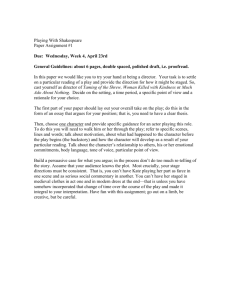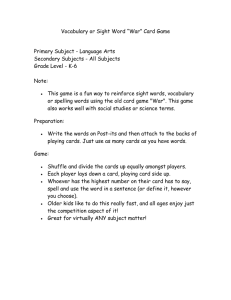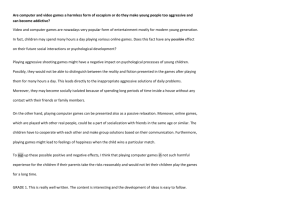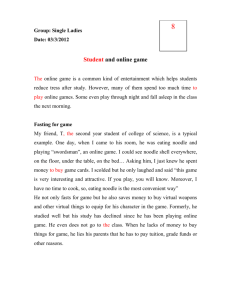answers to HW 1a
advertisement
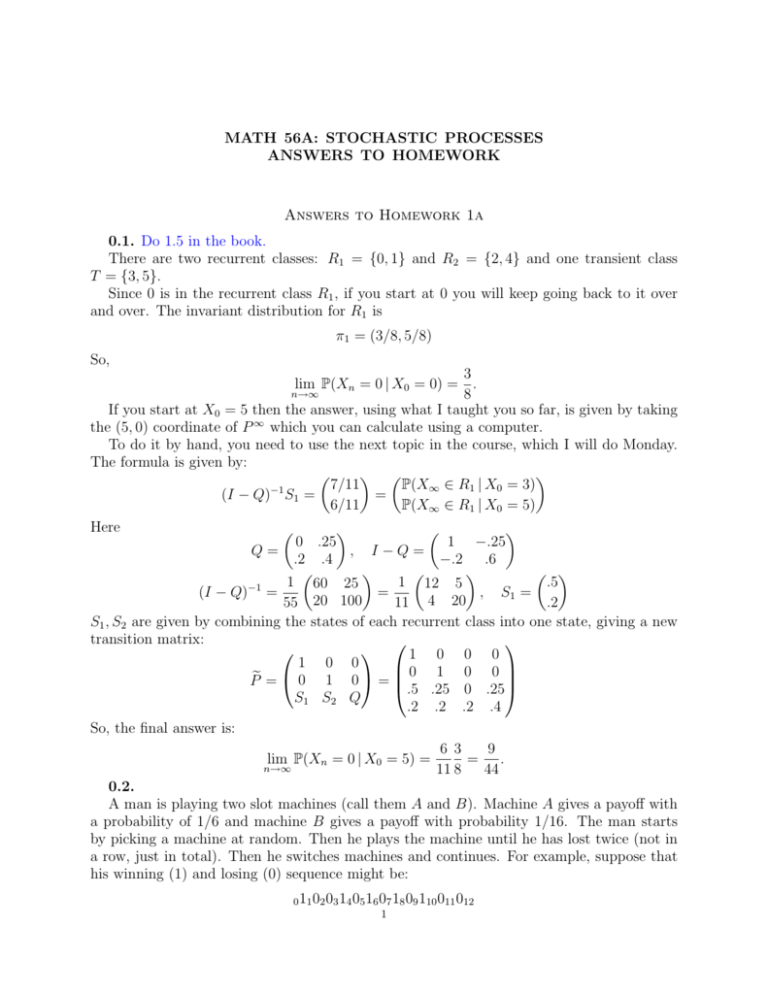
MATH 56A: STOCHASTIC PROCESSES
ANSWERS TO HOMEWORK
Answers to Homework 1a
0.1. Do 1.5 in the book.
There are two recurrent classes: R1 = {0, 1} and R2 = {2, 4} and one transient class
T = {3, 5}.
Since 0 is in the recurrent class R1 , if you start at 0 you will keep going back to it over
and over. The invariant distribution for R1 is
π1 = (3/8, 5/8)
So,
3
lim P(Xn = 0 | X0 = 0) = .
n→∞
8
If you start at X0 = 5 then the answer, using what I taught you so far, is given by taking
the (5, 0) coordinate of P ∞ which you can calculate using a computer.
To do it by hand, you need to use the next topic in the course, which I will do Monday.
The formula is given by:
7/11
P(X∞ ∈ R1 | X0 = 3)
−1
(I − Q) S1 =
=
6/11
P(X∞ ∈ R1 | X0 = 5)
Here
0 .25
1 −.25
Q=
, I −Q=
.2 .4
−.2 .6
1 60 25
.5
1 12 5
−1
(I − Q) =
=
, S1 =
55 20 100
11 4 20
.2
S1 , S2 are given by combining the states of each recurrent class into one state, giving a new
transition matrix:
1 0 0 0
1 0 0
0 1 0 0
Pe = 0 1 0 =
.5 .25 0 .25
S1 S2 Q
.2 .2 .2 .4
So, the final answer is:
6 3
9
lim P(Xn = 0 | X0 = 5) =
= .
n→∞
11 8
44
0.2.
A man is playing two slot machines (call them A and B). Machine A gives a payoff with
a probability of 1/6 and machine B gives a payoff with probability 1/16. The man starts
by picking a machine at random. Then he plays the machine until he has lost twice (not in
a row, just in total). Then he switches machines and continues. For example, suppose that
his winning (1) and losing (0) sequence might be:
0 11 02 03 14 05 16 07 18 09 110 011 012
1
Then he will switch machines after n = 2 since he lost twice. (He switches in the time
between n = 2 and n = 3). He switches back after n = 6 and then again after n = 10.
(a) Make this into a Markov chain with 4 states: A0 , A1 , B0 , B1 where the subscript keeps
track of the number of losses. [This is an example of recording information to convert
a stochastic process to first order.]
The states are:
A0 : The man is playing machine A and has not lost any games so far.
A1 : The man is playing machine A and has lost one gave so far.
B0 : The man is playing machine B and has not lost any games so far.
B1 : The man is playing machine B and has lost one gave so far.
The transition matrix is:
1/6 5/6
0
0
0
1/6 5/6
0
.
P =
0
0 1/16 15/16
15/16 0
0
1/16
“The man starts by picking a machine at random” means the initial distribution is
α = (1/2, 0, 1/2, 0)
since he starts at one of the two machines with equal probability but he starts with
no losses.
(b) What is the probability that the man will be playing machine A at n = 4 if he starts
at machine A? What about if he starts at a machine picked at random?
10
25
1
0
36
36
36
1
55
5·15
0
36
288
6·16 .
P2 =
2
1
30
152
0
2
16
16
162
15
15
5·15
+ 162 6·16 0 1612
6·16
The sum of the first two columns (indicating the probability of playing on machine
A after two rounds of play) is
(11/36, 1/36, 152 /162 , 1 − 1/162 )t .
The answer to the first question is given by the dot product of this with the first row
(which indicates the probability distribution after two rounds of play):
11
10
25 · 152
+
+
≈ 0.62655527
362 362 36 · 162
The dot product with the third row gives the probability of playing on machine A
after 4 rounds of play starting at machine B:
≈ 0.38871765
The answer to the second question is the average of these two numbers:
1
(0.62655527
2
+ 0.38871765) ≈ 0.50763646
(c) Find the invariant distribution.
The invariant distribution is proportional to
(6/5, 6/5, 16/15, 16/15) =
2
(9, 9, 8, 8).
15
So, it is
1
π = 34
(9, 9, 8, 8).
(d) In the long run, how much of the time will the man be playing the better machine?
The answer is the sum of the first two coordinates of the invariant distribution:
9
9
9
+
= .
34 34
17
0.3. Suppose that
0 0 0 1
0 0 1 0
P =
.4 .4 0 .2
.7 0 0 .3
(a) Find the unique invariant distribution and explain why it is unique.
The unique recurrent class is R = {1, 4}. So, the unique invariant distribution is
π = (7/17, 0, 0, 10/17).
(b) Draw the diagram and find the communication classes.
Draw arrows: 1 → 4 → 1, 2 → 3 → 2 and 3 → 1, 3 → 4.
The communication classes are the recurrent class R = {1, 4} and the transient
class T = {2, 3}.
(c) What is the probability that X100 is in the transient class given that you start in the
transient class?
You need to go back and forth between states 2 and 3 fifty times. So,
P(X100 ∈ T | X0 ∈ T ) = 0.450 ≈ 1.26765 ∗ 10−20 .
What about if you start at a random location?
In that case the probability is half of this:
P(X100 ∈ T ) = 21 0.450 ≈ 6.33825 ∗ 10−21 .
